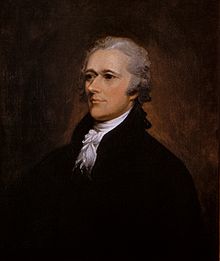Federalist Party
The term Federalist is used to describe two different groups in the history of the United States:
- Those politicians who supported the ratification of the Constitution between 1787 and 1789
- The politicians who supported the government policies of Presidents George Washington and John Adams
While the two groups overlap, they are not identical.
The "Federalists" or "Federalist Party" was originally the name given to the party that supported the American Constitution of 1787. Its name is found in the so-called Federalist Papers or the essays summarized in The Federalist by Alexander Hamilton, later the first U.S. Secretary of the Treasury, James Madison, later the fourth U.S. President, and John Jay, later the first Chief Justice of the United States, who explained their republican principles there in 1787/88 and thus justified the need for a strong federal government.
The first group got its name because they were in favor of signing the constitution that would create a closer federation between the former colonies, which until then were only loosely allied. It did not form a true party, but rather a movement of people with a common goal, which disbanded when the goal was achieved.
Federalists in the second sense were, from 1791, the supporters of Washington and Alexander Hamilton's governmental policy, such as Timothy Pickering (Secretary of State under John Adams). These aimed primarily at creating a strong central government, while their opponents sought rather a confederation of states, which would have left power with the individual states. These federalists were also not a party in the modern sense, but certainly in the sense of the time.
Important items on the political agenda of the federalists were the establishment of a first national bank (later dissolved) to stimulate the domestic economy and the creation of an army and fleet. The latter was successfully used in the war against North African pirates. With regard to the Revolutionary Wars in Europe, the Federalists remained strictly neutral. They also called for an active economic policy in terms of manufactures, trade and banking. In addition, they supported the concerns of the artisans over the interests of agriculture.
Personal differences between John Adams and Hamilton led to a split in the Federalists and contributed significantly to the electoral victory of the Democratic-Republican Party under Thomas Jefferson in 1800. The Federalists remained an important party in New England for the next several years, but increasingly lost federal political influence. After Hamilton was killed in a duel with Aaron Burr and Adams retired from political life, the Federalists lacked a leader and the party grew weaker.
As a party, the Federalists were no longer perceptible after 1815/1817 at the latest. The National Republican Party and the United States Whig Party can be regarded as at least partial successors to the Federalists (for example, the Federalist Daniel Webster was later a member first of the National Republicans and then of the Whigs). At its founding in the 1850s, the Republican Party also showed some borrowings from the positions of the former Federalists.

Federalist leader: Alexander Hamilton
Federalist presidential candidates
- John Adams: 1796, 1800
- Charles Cotesworth Pinckney: 1804, 1808
- DeWitt Clinton: 1812
- Rufus King: 1816
See also
- List of political parties of the United States
Questions and Answers
Q: What was the Federalist Party?
A: The Federalist Party was an American political party from 1792 to 1816.
Q: Who founded the Federalist Party?
A: Alexander Hamilton formed the party during George Washington's first term.
Q: What did Alexander Hamilton want for the government?
A: Hamilton wanted a strong national government with financial credibility.
Q: How did Hamilton build a network of supporters?
A: He and his network of treasury agents tried to link together friends of the government, especially merchants and bankers, in the new nation's dozen major cities.
Q: How did it become a national faction?
A: His attempts to manage politics in the national capital to get his plans through Congress brought strong responses across the country, which led to it becoming a national faction.
Q: What were some of its views on foreign policy?
A: The party opposed the War of 1812 and dwindled away after the war in 1816.
Q: What are Federalist Papers?
A:Federalist Papers are newspaper articles published by Hamilton and others from about 1790.
Search within the encyclopedia